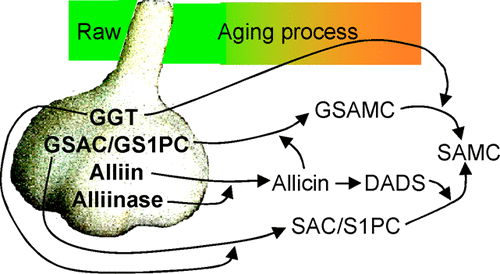当前位置:
X-MOL 学术
›
J. Agric. Food Chem.
›
论文详情
Our official English website, www.x-mol.net, welcomes your feedback! (Note: you will need to create a separate account there.)
Changes of S-Allylmercaptocysteine and γ-Glutamyl-S-allylmercaptocysteine Contents and Their Putative Production Mechanisms in Garlic Extract during the Aging Process
Journal of Agricultural and Food Chemistry ( IF 6.1 ) Pub Date : 2018-09-18 00:00:00 , DOI: 10.1021/acs.jafc.8b02541 Takuto Fujii 1 , Toshiaki Matsutomo 1 , Yukihiro Kodera 1
Journal of Agricultural and Food Chemistry ( IF 6.1 ) Pub Date : 2018-09-18 00:00:00 , DOI: 10.1021/acs.jafc.8b02541 Takuto Fujii 1 , Toshiaki Matsutomo 1 , Yukihiro Kodera 1
Affiliation

|
γ-Glutamyl-S-allylmercaptocysteine (GSAMC), a putative precursor compound of S-allylmercaptocysteine (SAMC), was isolated and identified from aged garlic extract (AGE). We analyzed the change of their contents in AGE during the aging process, chronologically from 1 to 22 months. The formation of these compounds occurred mostly during the early stage of the aging period: the SAMC content reached a maximum at approximately 4 months, whereas the GSAMC content reached a maximum at 1 month and then decreased during the subsequent aging period. To assess the possible relationship between the change of the two compounds during the aging process, we set up the model reactions with the hypothesis that GSAMC is produced from γ-glutamyl-S-allylcysteine (GSAC)/γ-gultamyl-S-1-propenylcysteine (GS1PC) and that SAMC is produced from GSAMC by endogenous γ-glutamyl transpeptidase (GGT) in garlic during the early stage of the aging process. We found that, in the model reactions, SAMC was produced from GSAMC by the garlic protein fraction having GGT activity and its production was suppressed by a GGT inhibitor. Furthermore, the production of GSAMC from allicin and GSAC/GS1PC was found in another model reaction. The reaction between allicin and GS1PC was faster than that between allicin and GSAC and, thus, may be involved in the production of GSAMC in the early stage of the aging process.
中文翻译:

大蒜提取物中衰老过程中S-烯丙基巯基半胱氨酸和γ-谷氨酰-S-烯丙基巯基半胱氨酸含量的变化及其可能的产生机理
γ-谷氨酰-S-烯丙基巯基半胱氨酸(GSAMC),一种假定的S-烯丙基巯基半胱氨酸(SAMC)的前体化合物,已从陈年大蒜提取物(AGE)中分离出来并鉴定出来。我们按时间顺序(从1到22个月)分析了衰老过程中AGE中其含量的变化。这些化合物的形成主要发生在老化阶段的早期:SAMC含量在约4个月达到最大值,而GSAMC含量在1个月达到最大值,然后在随后的老化时期下降。为了评估衰老过程中两种化合物变化之间的可能关系,我们建立了模型反应,并假设GSAMC由γ-谷氨酰-S产生-烯丙基半胱氨酸(GSAC)/γ-谷氨酰-S -1-丙烯基半胱氨酸(GS1PC),并且SAMC是在老化过程的早期由大蒜中的内源性γ-谷氨酰转肽酶(GGT)由GSAMC产生的。我们发现,在模型反应中,SAMC是由具有GGT活性的大蒜蛋白级分从GSAMC产生的,并且其产生受到GGT抑制剂的抑制。此外,在另一个模型反应中发现了大蒜素和GSAC / GS1PC产生的GSAMC。大蒜素和GS1PC之间的反应比大蒜素和GSAC之间的反应快,因此可能在老化过程的早期参与了GSAMC的生产。
更新日期:2018-09-18
中文翻译:

大蒜提取物中衰老过程中S-烯丙基巯基半胱氨酸和γ-谷氨酰-S-烯丙基巯基半胱氨酸含量的变化及其可能的产生机理
γ-谷氨酰-S-烯丙基巯基半胱氨酸(GSAMC),一种假定的S-烯丙基巯基半胱氨酸(SAMC)的前体化合物,已从陈年大蒜提取物(AGE)中分离出来并鉴定出来。我们按时间顺序(从1到22个月)分析了衰老过程中AGE中其含量的变化。这些化合物的形成主要发生在老化阶段的早期:SAMC含量在约4个月达到最大值,而GSAMC含量在1个月达到最大值,然后在随后的老化时期下降。为了评估衰老过程中两种化合物变化之间的可能关系,我们建立了模型反应,并假设GSAMC由γ-谷氨酰-S产生-烯丙基半胱氨酸(GSAC)/γ-谷氨酰-S -1-丙烯基半胱氨酸(GS1PC),并且SAMC是在老化过程的早期由大蒜中的内源性γ-谷氨酰转肽酶(GGT)由GSAMC产生的。我们发现,在模型反应中,SAMC是由具有GGT活性的大蒜蛋白级分从GSAMC产生的,并且其产生受到GGT抑制剂的抑制。此外,在另一个模型反应中发现了大蒜素和GSAC / GS1PC产生的GSAMC。大蒜素和GS1PC之间的反应比大蒜素和GSAC之间的反应快,因此可能在老化过程的早期参与了GSAMC的生产。


























 京公网安备 11010802027423号
京公网安备 11010802027423号